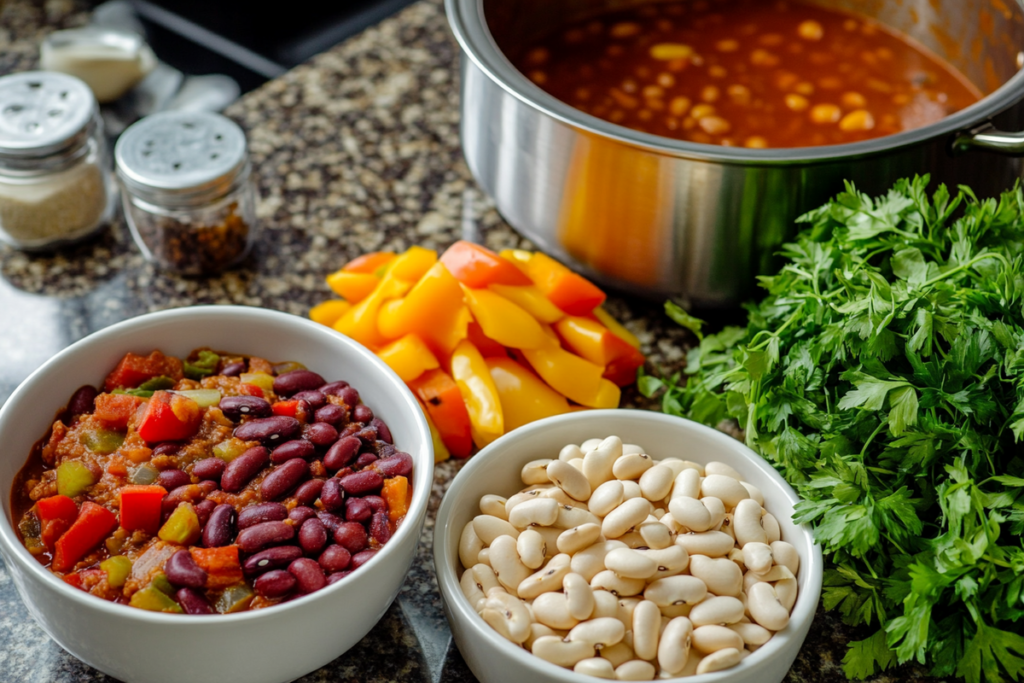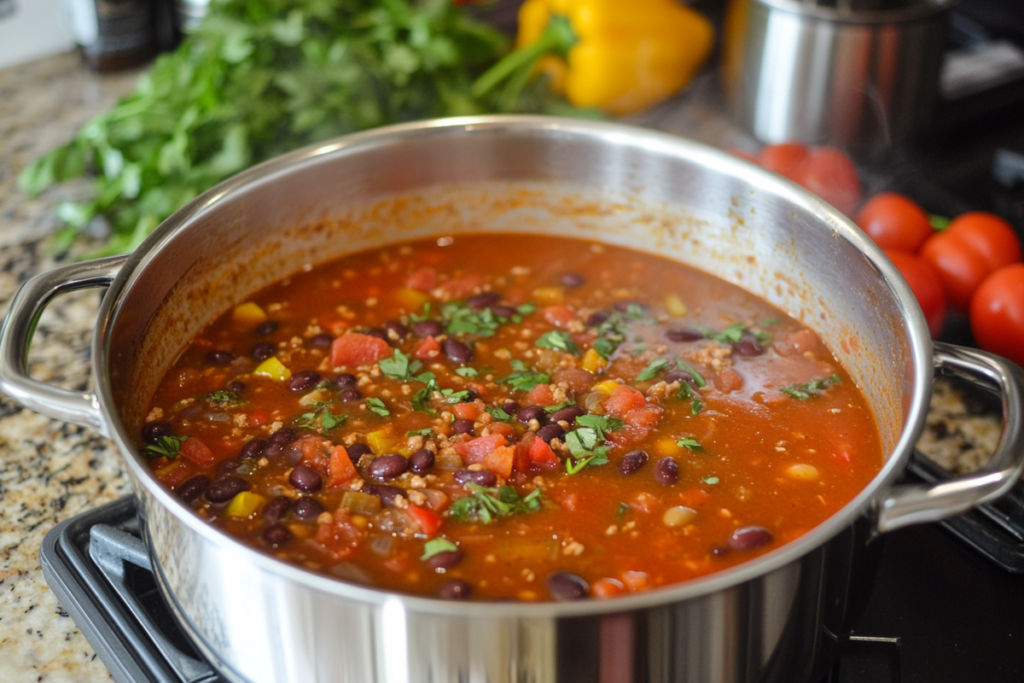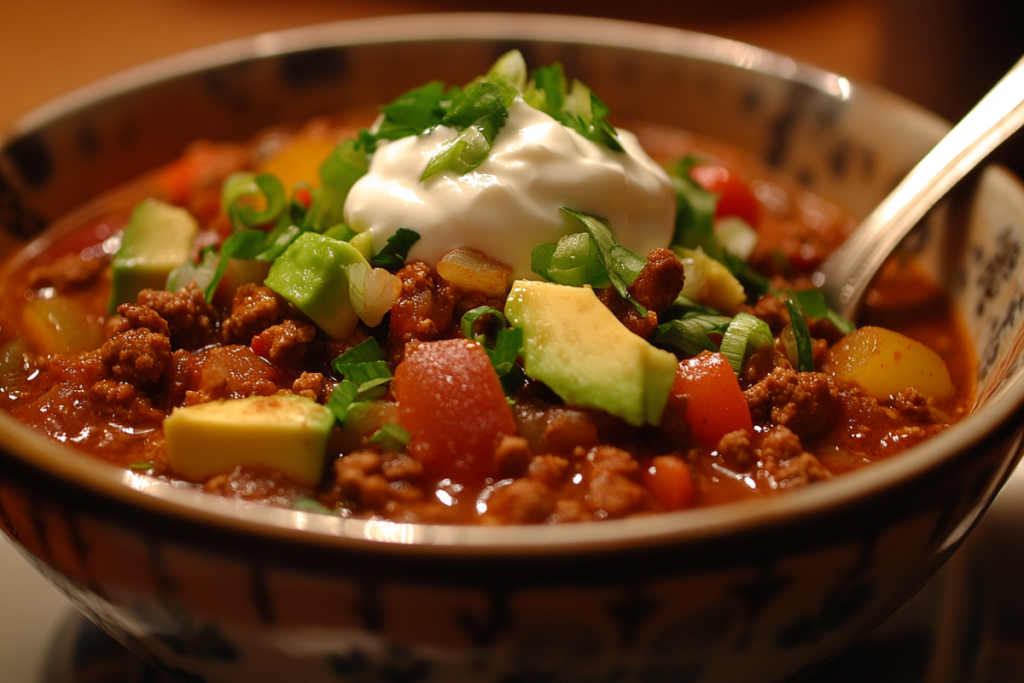When it comes to maintaining a heart-healthy diet, many people assume they have to give up their favorite comfort foods, but that’s not entirely true! One beloved dish, chili, can be made just as flavorful without overloading on sodium. A low sodium chili recipe offers a hearty, savory meal that’s perfect for anyone aiming to lower their salt intake without sacrificing taste. In this article, we’ll explore the essentials of creating a delicious chili that’s both healthy and satisfying. From understanding what makes a recipe “low sodium” to step-by-step cooking techniques and creative variations, this guide has it all.
Understanding Low Sodium Diets and the Appeal of Chili Recipes
Importance of Reducing Sodium Intake for Health
Sodium plays a critical role in bodily functions like nerve transmission and muscle contraction. However, too much of it can lead to high blood pressure, heart disease, and other health complications. The average diet often far exceeds the recommended daily sodium limit of 2,300 milligrams. A low sodium chili recipe can help bridge the gap between enjoying comfort food and sticking to a healthier lifestyle.
Reducing sodium doesn’t mean skimping on flavor. In fact, many spices, herbs, and fresh ingredients naturally enhance a dish, making up for the lack of salt. Plus, cutting down on sodium doesn’t only benefit those with hypertension—it’s a smart choice for anyone wanting to live a more balanced life.
Popularity of Chili as a Comfort Food
Chili holds a special place in the hearts of many. It’s versatile, easy to prepare, and downright satisfying. Whether served on a chilly evening or at a family gathering, this dish has a universal appeal. Traditionally, chili recipes often rely on high-sodium ingredients like canned goods and pre-packaged spice blends. But with a few mindful swaps, a low sodium version can taste just as hearty and flavorful.
Benefits of Combining a Low Sodium Diet with Chili Recipes
Why choose chili as a low sodium dish? The answer lies in its flexibility. You can load it up with fresh vegetables, lean proteins, and nutrient-packed beans—all while keeping the sodium content in check. By preparing it at home, you have complete control over what goes into the pot. It’s also a great way to introduce healthier eating habits to your family without anyone noticing the difference.
With the right recipe, a bowl of low sodium chili can become a staple in your meal rotation, providing warmth, comfort, and nutrition all at once. So, let’s dive into how you can make this classic dish work for your health goals!
What Constitutes a Low Sodium Chili Recipe
Defining Low Sodium in Culinary Terms
What makes a dish “low sodium”? The answer might surprise you. For a recipe to earn this label, it typically contains no more than 140 milligrams of sodium per serving. That’s a sharp contrast to the 800–1,200 milligrams found in many traditional chili recipes. High-sodium culprits include processed ingredients like canned beans, broths, and spice blends. By opting for fresh or no-salt-added alternatives, you can stay well within the guidelines without compromising on taste.
For those managing heart conditions or high blood pressure, adhering to these limits can make a noticeable difference in overall health. Even for the average person, lowering sodium intake helps reduce bloating and water retention, making it a win-win!
Key Ingredients in Low Sodium Chili
Building a flavorful chili begins with the right ingredients. Unlike store-bought products, fresh ingredients bring natural depth to your dish without the extra salt. Here’s what you’ll need:
- Lean Proteins: Options like ground turkey, chicken, or plant-based crumbles are not only healthier but also have less sodium than processed meats.
- Beans: Black beans, kidney beans, or pinto beans are excellent sources of protein and fiber. Choose dried beans or canned beans labeled “low sodium” or “no salt added.”
- Fresh Vegetables: Tomatoes, bell peppers, onions, and zucchini add both texture and nutrients. Crushed or diced fresh tomatoes can easily replace canned ones, which are often loaded with salt.
- Herbs and Spices: This is where the magic happens. Chili powder, cumin, paprika, and garlic bring bold flavors to your chili without relying on salt.
With these ingredients, your low sodium chili recipe will be rich in flavor and nutrition.
Ingredients to Avoid or Modify
Certain ingredients, though tempting, can quickly turn your low sodium chili into a sodium bomb. Here’s what to watch out for:
- High-Sodium Canned Goods: Canned tomatoes, beans, and broths often contain excessive amounts of salt. Always read labels and opt for “no salt added” varieties.
- Processed Meats: Sausages, bacon, and pre-seasoned ground meats are common in chili recipes but pack an unhealthy sodium punch.
- Pre-Packaged Spice Mixes: These often hide added salt and preservatives. Creating your own spice blend ensures full control over the sodium content.
By avoiding these common pitfalls, you’ll lay the groundwork for a dish that’s both heart-healthy and full of flavor.
Step-by-Step Guide to Preparing Low Sodium Chili
Selecting the Right Ingredients

The secret to an outstanding low sodium chili recipe lies in the quality of its ingredients. Start by choosing fresh produce and carefully checking labels for sodium content. Here’s a quick guide to help you shop smart:
- Fresh vs. Canned: Whenever possible, opt for fresh vegetables instead of canned ones. Fresh tomatoes, for instance, bring a natural sweetness that canned varieties can’t match.
- Low Sodium Alternatives: If canned goods are necessary, select those labeled “no salt added.” Rinse them thoroughly under cold water to remove excess sodium.
- Broths and Stocks: Use homemade vegetable or chicken broth. Store-bought versions can be high in sodium, even if they claim to be “low sodium.”
- Proteins: Choose lean ground turkey or chicken. If you prefer plant-based options, textured vegetable protein or crumbled tofu works well.
By taking these steps, you’ll ensure your dish is both flavorful and health-conscious.
Preparation Techniques to Enhance Flavor
Cooking low sodium doesn’t mean sacrificing taste. With the right techniques, you can create a chili that’s bursting with flavor:
- Sauté Your Vegetables: Begin by cooking onions, garlic, and bell peppers in a small amount of olive oil. This step builds a robust flavor base that will carry through the dish.
- Toast the Spices: Before adding liquids, lightly toast your chili powder, cumin, and paprika in the pan. This releases their natural oils, intensifying their aroma and flavor.
- Layer Your Ingredients: Add your ingredients in stages rather than dumping everything in at once. This allows each layer to cook evenly and develop its unique flavors.
These simple techniques elevate your chili from good to exceptional while keeping it low sodium.
Cooking Methods for Optimal Results

Now that your ingredients are prepped, it’s time to cook. There are several methods to consider, each with its own advantages:
- Slow Cooker: Perfect for busy days, a slow cooker allows the flavors to meld over several hours. Add all your ingredients, set it to low, and let it simmer.
- Stovetop: This classic method gives you more control. After sautéing your vegetables and toasting your spices, simmer your chili over low heat for about an hour.
- Pressure Cooker: For a faster option, use a pressure cooker. It retains flavor while cutting cooking time in half.
Regardless of your chosen method, the key is to simmer gently to allow the flavors to combine harmoniously.
Variations of Low Sodium Chili
Vegetarian and Vegan Options
For those who prefer meat-free meals, a vegetarian or vegan low sodium chili recipe is an excellent choice. Packed with protein, fiber, and bold flavors, these versions are just as satisfying as their meat-based counterparts:
- Plant-Based Proteins: Replace meat with lentils, crumbled tofu, or textured vegetable protein. Black beans and chickpeas also provide plenty of heartiness.
- Vegetable Medley: Add chopped zucchini, mushrooms, sweet potatoes, or corn for extra texture and natural sweetness.
- Flavor Boosters: Nutritional yeast, smoked paprika, and fresh cilantro can enhance the flavor without needing salt.
These plant-powered versions are perfect for Meatless Mondays or anyone looking to diversify their diet while keeping it healthy.
White Chicken Chili
Switching up the traditional red base for a creamy, tangy white version is another fantastic way to enjoy chili. Here’s how to craft a low sodium white chicken chili:
- Lean Protein: Use shredded chicken breast, a naturally low-sodium option.
- White Beans: Great Northern beans or cannellini beans add creaminess and protein. Opt for no-salt-added varieties.
- Green Chilies: Mild or spicy, they bring a zesty kick to the dish.
- Creamy Texture: Achieve this with plain low-fat yogurt or a splash of unsweetened almond milk.
This variation is lighter but still incredibly flavorful, making it a crowd-pleaser at any table.
Spicy Turkey Chili
For those who love a little heat, a low sodium spicy turkey chili offers the perfect balance of spice and heartiness.
- Ground Turkey: A leaner alternative to ground beef, it keeps the sodium low while packing in protein.
- Heat Sources: Use fresh jalapeños, serrano peppers, or cayenne powder to add the desired level of spiciness.
- Flavor Balancers: Sweeten the pot naturally with diced carrots or a splash of unsalted tomato paste.
- Herbaceous Finish: Top with fresh cilantro or parsley for a cooling contrast to the heat.
This variation proves that you don’t need salt to achieve bold, unforgettable flavors.
Serving Suggestions and Accompaniments

Low Sodium Side Dishes
No bowl of low sodium chili is complete without a side dish to complement its rich flavors. Choosing sides that align with your health goals is key. Here are some delicious low-sodium options:
- Whole Grain Bread or Cornbread: Freshly baked whole grain bread or homemade cornbread (made without added salt) pairs perfectly with chili. These options soak up the hearty broth while adding a wholesome touch.
- Fresh Salads: A crisp salad with mixed greens, cucumbers, and cherry tomatoes drizzled with a low-sodium vinaigrette balances the richness of chili.
- Steamed Vegetables: Serve your chili alongside lightly steamed broccoli, carrots, or green beans to add more fiber and nutrients to your meal.
These sides not only enhance the meal but also keep the sodium count in check.
Garnishing Ideas to Enhance Flavor
Garnishes are the cherry on top of a great chili, elevating the dish visually and flavor-wise. The right garnishes can add freshness, creaminess, or crunch:
- Fresh Herbs: Sprinkle chopped cilantro or parsley over your chili for a burst of color and flavor.
- Low-Fat Cheese or Yogurt: A dollop of plain, low-fat yogurt or a sprinkle of shredded cheese provides creaminess without overloading on salt.
- Avocado Slices: Creamy, heart-healthy avocado slices are a perfect addition to any chili bowl.
- Jalapeño Slices: If you enjoy heat, a few fresh jalapeño slices add a spicy kick without altering the sodium content.
Experimenting with garnishes is a fun way to customize each serving to your liking.
Portion Control and Dietary Considerations
Even though this low sodium chili recipe is healthier, portion control is still important. To maintain a balanced diet:
- Stick to a serving size of about 1 to 1.5 cups per person. This ensures you enjoy a satisfying meal without overindulging.
- Pair your chili with a light side dish to avoid consuming too many calories in one sitting.
- Track your daily sodium intake to ensure the rest of your meals stay within your dietary goals.
By focusing on portion sizes and balanced sides, you can make your low sodium chili both nourishing and satisfying.
Frequently Asked Questions (FAQs)
Can you eat chili on a low sodium diet?
Absolutely! By making a low sodium chili recipe at home, you can enjoy this comforting dish without exceeding your daily sodium limits. The key is to use fresh ingredients, avoid processed foods, and rely on herbs and spices to pack in flavor. With thoughtful preparation, chili can be a perfect addition to a low sodium diet.
Does homemade chili have a lot of sodium?
Homemade chili doesn’t have to be high in sodium. While traditional recipes often include high-sodium ingredients like canned beans, broths, and spice blends, substituting these with low-sodium or fresh alternatives keeps sodium levels in check. For example, choosing no-salt-added beans and making your own broth are great ways to reduce sodium significantly.
How do you reduce sodium in canned chili?
If you’re using canned chili, rinsing it under cold water can remove some of the excess sodium. Another trick is to dilute the chili with additional fresh or low-sodium ingredients, like diced tomatoes or cooked vegetables. This spreads out the sodium content while adding volume and nutrients to the dish.
How to make chili less sodium?
To lower the sodium in your chili, start by using fresh vegetables and lean proteins. Avoid pre-made spice mixes and instead use individual herbs and spices like cumin, paprika, and chili powder. Choose no-salt-added beans and broths, and don’t forget to taste as you go—seasoning with citrus juice or vinegar instead of salt can enhance flavors naturally.
Print
Delicious Low Sodium Chili Recipe for a Heart-Healthy Meal
- Total Time: 45 minutes
- Yield: 4 servings 1x
Description
This hearty and flavorful low-sodium chili is perfect for those who want a comforting bowl of chili without the extra salt. Packed with lean ground turkey, fiber-rich beans, and a medley of vegetables and spices, this dish proves that you don’t need a lot of sodium to enjoy a robust and satisfying meal. Perfect for weeknights or meal prep, this chili is both nutritious and delicious.
Ingredients
- 1 lb lean ground turkey or chicken
- 1 medium onion, diced
- 2 cloves garlic, minced
- 1 medium bell pepper, diced (any color)
- 1 medium zucchini, diced
- 1 cup diced tomatoes (no salt added)
- 1 ½ cups low-sodium chicken or vegetable broth
- 1 (15 oz) can kidney beans, drained and rinsed
- 1 (15 oz) can black beans, drained and rinsed
- 1 tbsp olive oil
- 2 tbsp tomato paste (no salt added)
- 2 tsp chili powder
- 1 tsp ground cumin
- 1 tsp smoked paprika
- ½ tsp ground coriander
- ½ tsp black pepper
- ¼ tsp cayenne pepper (optional, for heat)
- Juice of 1 lime
- 2 tbsp fresh cilantro, chopped (optional, for garnish)
Instructions
- Prepare the Base:
Heat olive oil in a large pot or Dutch oven over medium heat. Add the ground turkey and cook until browned, breaking it apart with a spoon, about 5-7 minutes. Remove from the pot and set aside. - Cook the Vegetables:
In the same pot, sauté the onion and garlic until fragrant, about 2-3 minutes. Add the bell pepper and zucchini, cooking for another 5 minutes until softened. - Combine the Ingredients:
Return the browned turkey to the pot. Stir in the diced tomatoes, tomato paste, and spices (chili powder, cumin, smoked paprika, coriander, black pepper, and cayenne, if using). Cook for 2 minutes to toast the spices. - Simmer the Chili:
Add the low-sodium broth and beans. Bring the mixture to a gentle boil, then reduce the heat and simmer for 20-25 minutes, stirring occasionally. - Finish and Serve:
Stir in the lime juice before serving to brighten the flavors. Garnish with fresh cilantro if desired. Serve hot and enjoy!
Notes
- For added texture, consider topping the chili with diced avocado or a dollop of plain Greek yogurt (low sodium).
- This recipe is naturally gluten-free if your broth and beans are certified gluten-free.
- Adjust the spice level by increasing or decreasing the cayenne pepper.
- Prep Time: 15 minutes
- Cook Time: 30 minutes
- Category: Lunch
- Method: Simmering
- Cuisine: American
Nutrition
- Serving Size: 1 bowl (approx. 1 ½ cups)
- Calories: 280
- Sugar: 6g
- Sodium: 150mg
- Fat: 7g
- Saturated Fat: 1g
- Unsaturated Fat: 6g
- Trans Fat: 0g
- Carbohydrates: 28g
- Fiber: 9g
- Protein: 28g
- Cholesterol: 55mg
Keywords: Low-Sodium Chili, Healthy Chili, No Salt Added, Easy Chili Recipe, Gluten-Free

